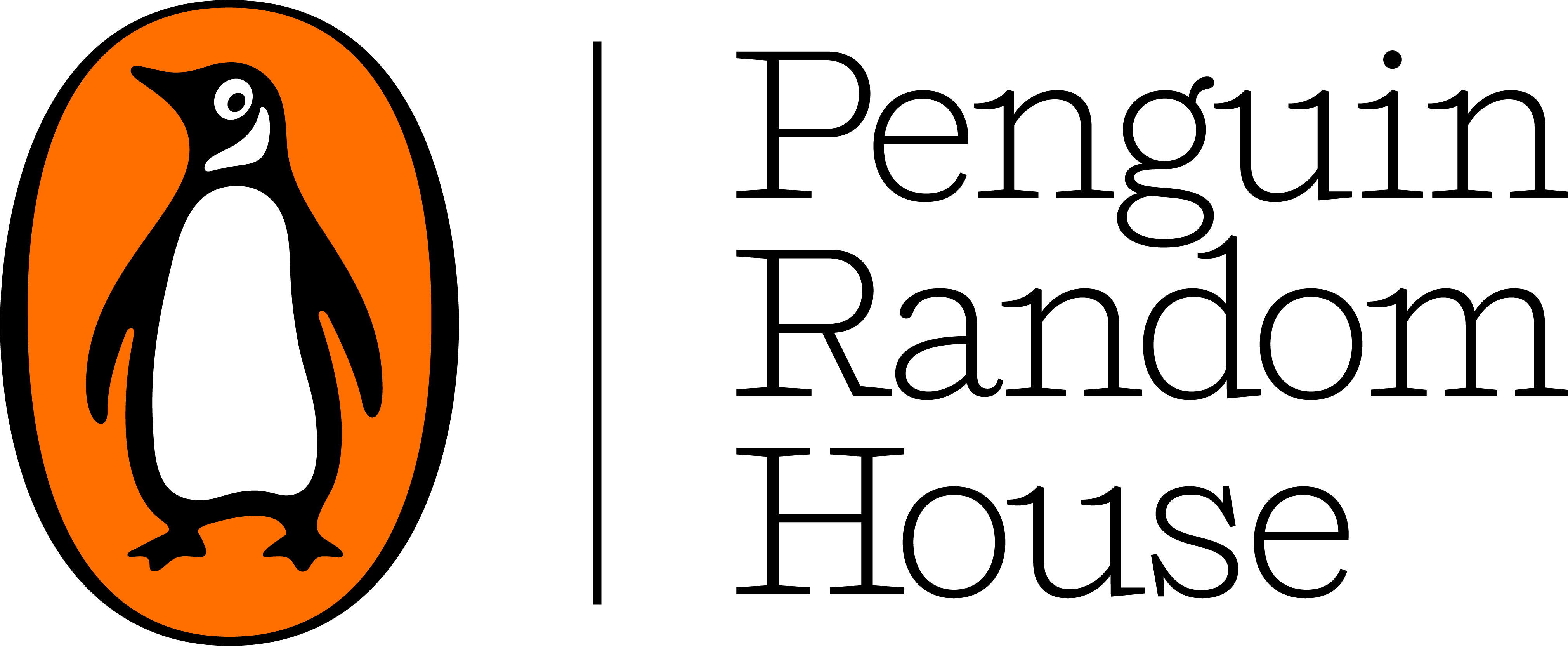Bertelsmann Reduces Carbon Footprint in 2016
December 4, 2017
 As part of our Igloo Climate Change series, we are presenting highlights from Bertelsmann’s recently released Carbon Footprint 2016 Report that provides information on the development of relevant environmental indicators and climate emissions across our majority shareholder and its divisions.
As part of our Igloo Climate Change series, we are presenting highlights from Bertelsmann’s recently released Carbon Footprint 2016 Report that provides information on the development of relevant environmental indicators and climate emissions across our majority shareholder and its divisions.
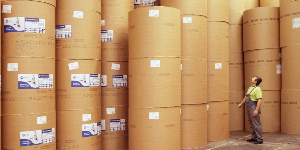 At Bertelsmann’s printing and publishing businesses, paper will remain the most important natural resource for the foreseeable future. As part of an ongoing effort to protect the environment and climate, it is all the more important than ever that paper used comes from sustainable forestry or recycling. In 2016, the proportion of paper Bertelsmann companies purchased from sustainable sources rose significantly from 74 percent to 86 percent. Meanwhile, overall paper consumption was down slightly year-on-year by 10,000 tons (roughly one percent), to 1.85 million tons. Bertelsmann’s annual paper consumption corresponds to a column of trucks loaded with rolls of paper that stretches more than 470 miles – roughly the distance from Hamburg to Munich. To complement its Paper Policy, Bertelsmann strives to increase the share of recycled paper and paper from certified sustainable forestry to more than 90 percent by 2020. Among Penguin Random House’s 2020 Social Responsibility Commitments, our company will source 100 percent of the paper we use worldwide from a certified forest-management standard such as FSC, SFI, and/or PEFC.
“Be Green” Efforts Continue to Have Positive Impact on Resource Conservation and Waste Prevention
At Bertelsmann’s printing and publishing businesses, paper will remain the most important natural resource for the foreseeable future. As part of an ongoing effort to protect the environment and climate, it is all the more important than ever that paper used comes from sustainable forestry or recycling. In 2016, the proportion of paper Bertelsmann companies purchased from sustainable sources rose significantly from 74 percent to 86 percent. Meanwhile, overall paper consumption was down slightly year-on-year by 10,000 tons (roughly one percent), to 1.85 million tons. Bertelsmann’s annual paper consumption corresponds to a column of trucks loaded with rolls of paper that stretches more than 470 miles – roughly the distance from Hamburg to Munich. To complement its Paper Policy, Bertelsmann strives to increase the share of recycled paper and paper from certified sustainable forestry to more than 90 percent by 2020. Among Penguin Random House’s 2020 Social Responsibility Commitments, our company will source 100 percent of the paper we use worldwide from a certified forest-management standard such as FSC, SFI, and/or PEFC.
“Be Green” Efforts Continue to Have Positive Impact on Resource Conservation and Waste Prevention
 A total of 380 Bertelsmann companies at nearly 400 locations across all divisions around the world participated in the company’s annual collection of environmental data. Numerous committed colleagues volunteered to support the recording of key figures on energy and paper consumption, water and waste. The worldwide environmental data collection is coordinated by “be green” experts at the divisions. At the Group level, the environmental data from the companies and sites are combined and the sum of all greenhouse gas emissions is determined. The results of the Carbon Footprint report not only create transparency about impacts on the environment and climate, as well as on Bertelsmann’s environmental performance, but also enables the management to derive measures for improvement.
The sharing of knowledge and experiences in the Bertelsmann “be green” network, and cooperation in energy efficiency projects, continue to help reduce energy consumption and emissions, costs, and effort.
Even in an increasingly digital media landscape, printed books, magazines, brochures and leaflets will continue to have their place, which is why, going forward, resource conservation and waste prevention will continue to play a major role at Bertelsmann across the paper value chain. To safeguard forests, which are valuable for climate protection and biodiversity, Bertelsmann advocates responsible paper procurement. In their role as print service providers and paper buyers, Bertelsmann companies offer their customers an extensive range of sustainably certified and carbonneutral print products.
To read the complete Bertelsmann Carbon Footprint 2016 Report, click here.
A total of 380 Bertelsmann companies at nearly 400 locations across all divisions around the world participated in the company’s annual collection of environmental data. Numerous committed colleagues volunteered to support the recording of key figures on energy and paper consumption, water and waste. The worldwide environmental data collection is coordinated by “be green” experts at the divisions. At the Group level, the environmental data from the companies and sites are combined and the sum of all greenhouse gas emissions is determined. The results of the Carbon Footprint report not only create transparency about impacts on the environment and climate, as well as on Bertelsmann’s environmental performance, but also enables the management to derive measures for improvement.
The sharing of knowledge and experiences in the Bertelsmann “be green” network, and cooperation in energy efficiency projects, continue to help reduce energy consumption and emissions, costs, and effort.
Even in an increasingly digital media landscape, printed books, magazines, brochures and leaflets will continue to have their place, which is why, going forward, resource conservation and waste prevention will continue to play a major role at Bertelsmann across the paper value chain. To safeguard forests, which are valuable for climate protection and biodiversity, Bertelsmann advocates responsible paper procurement. In their role as print service providers and paper buyers, Bertelsmann companies offer their customers an extensive range of sustainably certified and carbonneutral print products.
To read the complete Bertelsmann Carbon Footprint 2016 Report, click here. Philomel’s Jill Santopolo on the Creation of Chelsea Clinton’s IT’S YOUR WORLD
April 20, 2017
 In this new installment of our Climate Change series, Jill Santopolo, Editorial Director, Philomel Books, tells us about her key role in the creation of Chelsea Clinton’s IT’S YOUR WORLD: Get Informed, Get Inspired and Get Going. Climate Change is one of the big issues covered in the book, including a detailed “Weather Report” section. Young readers are
In this new installment of our Climate Change series, Jill Santopolo, Editorial Director, Philomel Books, tells us about her key role in the creation of Chelsea Clinton’s IT’S YOUR WORLD: Get Informed, Get Inspired and Get Going. Climate Change is one of the big issues covered in the book, including a detailed “Weather Report” section. Young readers are

Jill Santopolo[/caption] IT’S YOUR WORLD actually came to be because of television. Chelsea had appeared on The Daily Show with Jon Stewart to talk about global health, and I happened to be sitting on my couch watching TV that night. I was so impressed with the way in which Chelsea was able to explain complicated subjects in ways that were easy to understand that I reached out and asked her if she might be interested in writing a book for young readers that talked to them about the biggest issues facing our world today. It turned out that Chelsea had already been thinking about doing just that. And, of course, when you’re talking about big issues facing our world, climate change is one of them. We decided that the book would be divided into four sections focusing on the economy, rights, health, and the environment. Within those sections, there are smaller chapters in which Chelsea included explanations, features on kids (and some adults) who are working to make a difference in those areas, and then Get Going! lists of actions readers can take to make a difference themselves. That same structure is in the Weather Report section. How would you describe the experience of working with Ms. Clinton as her editor on this project and what was involved in establishing a narrative voice that would grab and hold the interest of young readers? It’s was truly a pleasure to work with Chelsea on IT’S YOUR WORLD. She’s such a thoughtful, intelligent person, and I think those qualities are reflected in her writing. As far as tweaking her narrative voice for young readers, we talked about the idea of writing as if she were having a conversation with one of her nieces or nephews, which is why I think her voice in the book sounds so natural and so much like her.
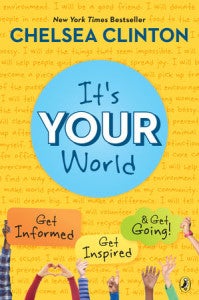 Climate Change is of urgent relevance to us all today. How did you and Ms. Clinton address this environmental crisis in IT’S YOUR WORLD, sharing insights and details, in a way that would not only inform but inspire action?
I think Chelsea did a remarkable job of explaining exactly what climate change is and the reasons it’s happening—both the large ones and the small ones. Because of the ways she’s able to break down this issue into bite-sized pieces, I think it’s easy for young readers to see how they, personally can make a difference by doing small things like recycling, bringing reusable bags on shopping trips, taking short showers instead of baths, turning off the water while brushing teeth, riding a bike instead of taking a car, and so much more. One of the themes of IT’S YOUR WORLD is that every bit count, and that a ton of small actions can make a big difference. That’s one of the messages I think is the most empowering about the book.
What do you feel will be the primary environmental-related takeaways from IT’S YOUR WORLD that young readers will be able to integrate into their everyday lives?
What I hope young readers will take away from IT’S YOUR WORLD is that you’re never too young (or too old, for that matter!) to make a difference. Whether it’s one of the smaller actions I mentioned above or starting something larger, like the incredible kids Chelsea features in her books have done, it takes all of us, working together, to create a better future for our planet and ourselves.
As part of Penguin Random House’s ongoing commitment to social responsibility and business practices that minimize our impact on the environment, our Climate Change series is meant to further the discussion.
Climate Change is of urgent relevance to us all today. How did you and Ms. Clinton address this environmental crisis in IT’S YOUR WORLD, sharing insights and details, in a way that would not only inform but inspire action?
I think Chelsea did a remarkable job of explaining exactly what climate change is and the reasons it’s happening—both the large ones and the small ones. Because of the ways she’s able to break down this issue into bite-sized pieces, I think it’s easy for young readers to see how they, personally can make a difference by doing small things like recycling, bringing reusable bags on shopping trips, taking short showers instead of baths, turning off the water while brushing teeth, riding a bike instead of taking a car, and so much more. One of the themes of IT’S YOUR WORLD is that every bit count, and that a ton of small actions can make a big difference. That’s one of the messages I think is the most empowering about the book.
What do you feel will be the primary environmental-related takeaways from IT’S YOUR WORLD that young readers will be able to integrate into their everyday lives?
What I hope young readers will take away from IT’S YOUR WORLD is that you’re never too young (or too old, for that matter!) to make a difference. Whether it’s one of the smaller actions I mentioned above or starting something larger, like the incredible kids Chelsea features in her books have done, it takes all of us, working together, to create a better future for our planet and ourselves.
As part of Penguin Random House’s ongoing commitment to social responsibility and business practices that minimize our impact on the environment, our Climate Change series is meant to further the discussion. Penguin Press’ Scott Moyers on Yvon Chouinard and LET MY PEOPLE GO SURFING
January 27, 2017
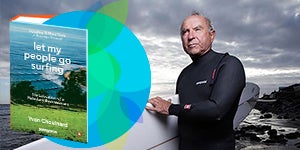 As Penguin Random House continues its ongoing commitment to social responsibility and business practices that minimize our impact on the environment, our new Climate Change series article features an interview with Penguin Press Vice President and Publisher Scott Moyers. He worked closely with world renowned environmentalist
As Penguin Random House continues its ongoing commitment to social responsibility and business practices that minimize our impact on the environment, our new Climate Change series article features an interview with Penguin Press Vice President and Publisher Scott Moyers. He worked closely with world renowned environmentalist
 Scott Moyers[/caption]
What brought about your initial contact with Yvon Chouinard and how would you characterize the experience and process of working with him as his book editor and publisher while presenting all aspects of his life and business?
Yvon Chouinard is powerfully inspiring because he has stubbornly refused to do anything with his business that does not advance its core mission: “to use business to inspire and implement solutions to the environmental crisis.” You can’t be in partnership with him without learning that, one way or another. I was submitted the book by his agent, Susan Golomb, in 2004 or 2005, and I knew enough about Patagonia’s brand halo, as they say, and was sufficiently taken by the voice on the page, which even in proposal form had that thrilling ring of authenticity and irreverence, that I went for it, and was fortunate enough to prevail in a heated auction. (It helped that no one has a bigger crush on Yvon Chouinard than Ann Godoff.) But really diving off the deep end with him was something else entirely. First, everything was slightly irreverent, and counterintuitive – what business leader calls his memoir “Let My People Go Surfing?” Which is from the company policy that when the surf’s up, employees should feel free to hit it. And he wanted to do an oddball trim size, with all sorts of funky sidebars and a lot of art. And he and Patagonia nudged us over to using a different kind of paper, recycled, of course. And on and on.
[caption id="attachment_4877" align="alignleft" width="300"]
Scott Moyers[/caption]
What brought about your initial contact with Yvon Chouinard and how would you characterize the experience and process of working with him as his book editor and publisher while presenting all aspects of his life and business?
Yvon Chouinard is powerfully inspiring because he has stubbornly refused to do anything with his business that does not advance its core mission: “to use business to inspire and implement solutions to the environmental crisis.” You can’t be in partnership with him without learning that, one way or another. I was submitted the book by his agent, Susan Golomb, in 2004 or 2005, and I knew enough about Patagonia’s brand halo, as they say, and was sufficiently taken by the voice on the page, which even in proposal form had that thrilling ring of authenticity and irreverence, that I went for it, and was fortunate enough to prevail in a heated auction. (It helped that no one has a bigger crush on Yvon Chouinard than Ann Godoff.) But really diving off the deep end with him was something else entirely. First, everything was slightly irreverent, and counterintuitive – what business leader calls his memoir “Let My People Go Surfing?” Which is from the company policy that when the surf’s up, employees should feel free to hit it. And he wanted to do an oddball trim size, with all sorts of funky sidebars and a lot of art. And he and Patagonia nudged us over to using a different kind of paper, recycled, of course. And on and on.
[caption id="attachment_4877" align="alignleft" width="300"] Yvon Chouinard[/caption]
But what really hit me was the story of the business itself. Just one story for now: there came a point when Patagonia commissioned a holistic environmental impact study of their entire business. What came back surprised and dismayed them: the worst thing they were doing to the planet was using so much factory-farmed cotton. As you can imagine, cotton shirts, etc., make up a big chunk of the business. What did they do? They pulled all of their cotton products, reinvented their supply chain, sourced their cotton ethically and in such a way as to catalyze environmentally responsible cotton growing more generally… in short, they used their market power to be a force for good and not ill. And ultimately, in the long run, they were more profitable by doing so! In the short run, of course, they had to absorb a tremendous hit to the bottom line. Needless to say, if they were a publicly held company, this might have been impossible, even unimaginable.Though thanks in no small part to Patagonia’s example, there’s been a change in consciousness, and perhaps it’s less unimaginable than it was. I hope this book has contributed to that; I think it has.
How does LET MY PEOPLE GO SURFING, divided into a History of Patagonia and eight Philosophies sections, best inform and inspire readers through key takeaways from this environmentally-responsible businessman/adventurer and his company?
I think the bottom-line takeaway for your own life and work is that, in area after area – design, production, distribution, marketing, finance, HR, management, environmental stewardship – if you don’t blink, if you keep fear at bay and keep your focus on the most quality for the least harm, you will be a magnet for talented, big-hearted colleagues and customers, and your story will carry. Every time this company took a short-term hit to innovate in the direction of greater responsibility for the state and fate of the earth, the more successful they have been in the long term.
How transferable are Mr. Chouinard’s approaches to business, life and the environment to other industries and individual readers?
No one wants to leave their values at home when they come to work. Yvon Chouinard never did, and his company has been an enormous force for the good. We all are part of the problem that is the global sustainability crisis, including global warming, one way or another. Activism and capitalism don’t have to be opposed, in fact they can’t be, if we’re going to keep this planet of ours and all the creatures on it.
What factors were involved in the decision to produce a new edition of LET MY PEOPLE GO SURFING on the 10th anniversary of its first publication and what are examples of some of the most significant new content?
Yvon Chouinard[/caption]
But what really hit me was the story of the business itself. Just one story for now: there came a point when Patagonia commissioned a holistic environmental impact study of their entire business. What came back surprised and dismayed them: the worst thing they were doing to the planet was using so much factory-farmed cotton. As you can imagine, cotton shirts, etc., make up a big chunk of the business. What did they do? They pulled all of their cotton products, reinvented their supply chain, sourced their cotton ethically and in such a way as to catalyze environmentally responsible cotton growing more generally… in short, they used their market power to be a force for good and not ill. And ultimately, in the long run, they were more profitable by doing so! In the short run, of course, they had to absorb a tremendous hit to the bottom line. Needless to say, if they were a publicly held company, this might have been impossible, even unimaginable.Though thanks in no small part to Patagonia’s example, there’s been a change in consciousness, and perhaps it’s less unimaginable than it was. I hope this book has contributed to that; I think it has.
How does LET MY PEOPLE GO SURFING, divided into a History of Patagonia and eight Philosophies sections, best inform and inspire readers through key takeaways from this environmentally-responsible businessman/adventurer and his company?
I think the bottom-line takeaway for your own life and work is that, in area after area – design, production, distribution, marketing, finance, HR, management, environmental stewardship – if you don’t blink, if you keep fear at bay and keep your focus on the most quality for the least harm, you will be a magnet for talented, big-hearted colleagues and customers, and your story will carry. Every time this company took a short-term hit to innovate in the direction of greater responsibility for the state and fate of the earth, the more successful they have been in the long term.
How transferable are Mr. Chouinard’s approaches to business, life and the environment to other industries and individual readers?
No one wants to leave their values at home when they come to work. Yvon Chouinard never did, and his company has been an enormous force for the good. We all are part of the problem that is the global sustainability crisis, including global warming, one way or another. Activism and capitalism don’t have to be opposed, in fact they can’t be, if we’re going to keep this planet of ours and all the creatures on it.
What factors were involved in the decision to produce a new edition of LET MY PEOPLE GO SURFING on the 10th anniversary of its first publication and what are examples of some of the most significant new content?
 Back in 2006, “sustainable business” was just emerging as a concept in mainstream terms. Part of the good news of the past decade is that sustainability has become cooked in to the mix of business education, at the MBA level and down, and LET MY PEOPLE GO SURFING is widely taught. The past decade has been a period of great growth and thus change for Patagonia, and it has also really doubled down and then some on its environmental activism, so there was so much more to tell. Yvon added a good 20% of new material to the book, including an entirely new chapter on environmental activism, and Naomi Klein has added a passionate new foreword. There are revisions throughout the book, my favorite being that it’s now in four-color and Yvon and Patagonia have added many wonderful new photographs. One way or another, all of the additions only sharpen the point, which is that, as Naomi Klein puts it in her foreword, “This is the story of an attempt to do more than change a single corporation – it is an attempt to challenge the culture of consumption that is at the heart of the global ecological crisis.” And to have fun doing it! Contagious fun, contagious righteousness, contagious success – that’s Yvon Chouinard and Patagonia, and that’s LET MY PEOPLE GO SURFING, now cleaned up for the next 10 years, and then some.
Back in 2006, “sustainable business” was just emerging as a concept in mainstream terms. Part of the good news of the past decade is that sustainability has become cooked in to the mix of business education, at the MBA level and down, and LET MY PEOPLE GO SURFING is widely taught. The past decade has been a period of great growth and thus change for Patagonia, and it has also really doubled down and then some on its environmental activism, so there was so much more to tell. Yvon added a good 20% of new material to the book, including an entirely new chapter on environmental activism, and Naomi Klein has added a passionate new foreword. There are revisions throughout the book, my favorite being that it’s now in four-color and Yvon and Patagonia have added many wonderful new photographs. One way or another, all of the additions only sharpen the point, which is that, as Naomi Klein puts it in her foreword, “This is the story of an attempt to do more than change a single corporation – it is an attempt to challenge the culture of consumption that is at the heart of the global ecological crisis.” And to have fun doing it! Contagious fun, contagious righteousness, contagious success – that’s Yvon Chouinard and Patagonia, and that’s LET MY PEOPLE GO SURFING, now cleaned up for the next 10 years, and then some. There’s a Book for That: Global Warming
January 18, 2017
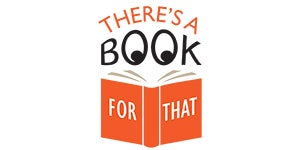 Did you know that 2016 marked the third year in a row of Earth’s highest temperature in recorded history? Government scientists say the cause is mostly man-made global warming with help from a natural El Nino. The announcement came this week from NASA and the National Oceanic and Atmospheric Administration. They said last year passed 2015 as the hottest year on record. This
Did you know that 2016 marked the third year in a row of Earth’s highest temperature in recorded history? Government scientists say the cause is mostly man-made global warming with help from a natural El Nino. The announcement came this week from NASA and the National Oceanic and Atmospheric Administration. They said last year passed 2015 as the hottest year on record. This
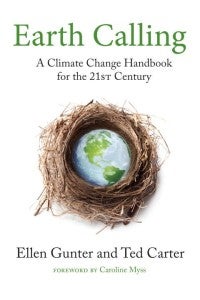 EARTH CALLING: A CLIMATE CHANGE HANDBOOK FOR THE 21ST CENTURY by Ellen Gunter, Ted Carter, Caroline Myss
Our earliest mythologies tell us we all start as a little bit of dirt. These stories carry a profound message: each of us is born with a deep and abiding connection to the earth, one that many of us have lost touch with. The Silent Spring for today’s environmental activists, this book offers an invitation to reestablish our relationship with nature to repair our damaged environment.
EARTH CALLING: A CLIMATE CHANGE HANDBOOK FOR THE 21ST CENTURY by Ellen Gunter, Ted Carter, Caroline Myss
Our earliest mythologies tell us we all start as a little bit of dirt. These stories carry a profound message: each of us is born with a deep and abiding connection to the earth, one that many of us have lost touch with. The Silent Spring for today’s environmental activists, this book offers an invitation to reestablish our relationship with nature to repair our damaged environment.
 THE WHOLE STORY OF CLIMATE: WHAT SCIENCE REVEALS ABOUT THE NATURE OF ENDLESS CHANGE by E. Kirsten Peters
This book, written by a geologist, describes the important contributions that geology has made to our understanding of climate change. What emerges is a much more complex and nuanced picture than is usually presented.
THE WHOLE STORY OF CLIMATE: WHAT SCIENCE REVEALS ABOUT THE NATURE OF ENDLESS CHANGE by E. Kirsten Peters
This book, written by a geologist, describes the important contributions that geology has made to our understanding of climate change. What emerges is a much more complex and nuanced picture than is usually presented.
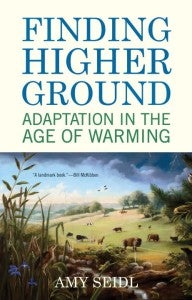 FINDING HIGHER GROUND: ADAPTATION IN THE AGE OF WARMING by Amy Seidl
In Finding Higher Ground, Amy Seidl takes the uniquely positive—yet realistic—position that humans and animals can adapt and persist despite these changes. Drawing on an emerging body of scientific research, Seidl brings us stories of adaptation from the natural world and from human communities.
FINDING HIGHER GROUND: ADAPTATION IN THE AGE OF WARMING by Amy Seidl
In Finding Higher Ground, Amy Seidl takes the uniquely positive—yet realistic—position that humans and animals can adapt and persist despite these changes. Drawing on an emerging body of scientific research, Seidl brings us stories of adaptation from the natural world and from human communities.
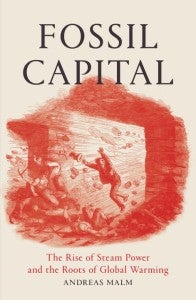 FOSSIL CAPITAL: THE RISE OF STEAM POWER AND THE ROOTS OF GLOBAL WARMING by Andreas Malm
The more we know about the catastrophic implications of climate change, the more fossil fuels we burn. How did we end up in this mess? In this masterful new history, Andreas Malm claims it all began in Britain with the rise of steam power.
FOSSIL CAPITAL: THE RISE OF STEAM POWER AND THE ROOTS OF GLOBAL WARMING by Andreas Malm
The more we know about the catastrophic implications of climate change, the more fossil fuels we burn. How did we end up in this mess? In this masterful new history, Andreas Malm claims it all began in Britain with the rise of steam power.
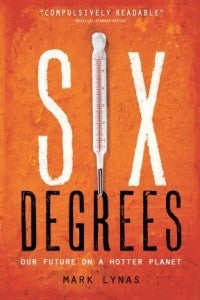 SIX DEGREES: OUR FUTURE ON A HOTTER PLANET by Mark Lynas
Possibly the most graphic treatment of global warming that has yet been published, Six Degrees uses accessible journalistic prose to distil what environmental scientists portend about the consequences of human pollution for the next hundred years.
FOR YOUNGER READERS
SIX DEGREES: OUR FUTURE ON A HOTTER PLANET by Mark Lynas
Possibly the most graphic treatment of global warming that has yet been published, Six Degrees uses accessible journalistic prose to distil what environmental scientists portend about the consequences of human pollution for the next hundred years.
FOR YOUNGER READERS
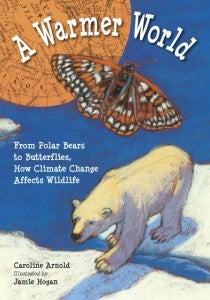 A WARMER WORLD: FROM POLAR BEARS TO BUTTERFLIES HOW CLIMATE CHANGE AFFECTS WILDLIFE by Caroline Arnold, Jamie Hogan
The golden toad used to inhabit the cloud forests of Costa Rica, but when the weather became too warm and dried up the pools where its eggs hatched, the golden toad disappeared. It has not been seen in more than twenty years. This amphibian is just one of several species in A WARMER WORLD, a thought-provoking and informative account of how global climate change has affected wildlife over the past several decades.
A WARMER WORLD: FROM POLAR BEARS TO BUTTERFLIES HOW CLIMATE CHANGE AFFECTS WILDLIFE by Caroline Arnold, Jamie Hogan
The golden toad used to inhabit the cloud forests of Costa Rica, but when the weather became too warm and dried up the pools where its eggs hatched, the golden toad disappeared. It has not been seen in more than twenty years. This amphibian is just one of several species in A WARMER WORLD, a thought-provoking and informative account of how global climate change has affected wildlife over the past several decades.
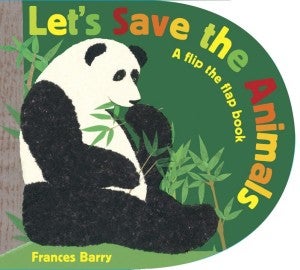 LET’S SAVE THE ANIMALS: A FLIP THE FLAP BOOK by Frances Barry
Bold illustrations, big flaps, and an ingenious die-cut design invite young readers to peek at the lives of endangered animals — and learn how to help.
LET’S SAVE THE ANIMALS: A FLIP THE FLAP BOOK by Frances Barry
Bold illustrations, big flaps, and an ingenious die-cut design invite young readers to peek at the lives of endangered animals — and learn how to help.
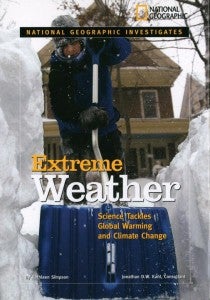 NATIONAL GEOGRAPHIC INVESTIGATES: EXTREME WEATHER: SCIENCE TACKLES GLOBAL WARMING AND CLIMATE CHANGE by Kathleen Simpson, Jonathan D. W. Kahl
Join the weather scientists who are using modern technology, including satellites and supercomputers, to produce a weather forecast for Earth’s future. Extreme Weather gives readers the expert’s views and highlights the climate changes that may be on the horizon.
NATIONAL GEOGRAPHIC INVESTIGATES: EXTREME WEATHER: SCIENCE TACKLES GLOBAL WARMING AND CLIMATE CHANGE by Kathleen Simpson, Jonathan D. W. Kahl
Join the weather scientists who are using modern technology, including satellites and supercomputers, to produce a weather forecast for Earth’s future. Extreme Weather gives readers the expert’s views and highlights the climate changes that may be on the horizon.
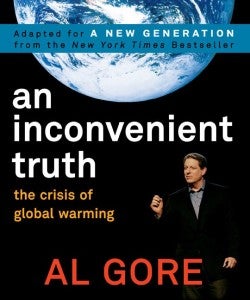 AN INCONVENIENT TRUTH: THE CRISIS OF GLOBAL WARMING (Middle grade edition) by Al Gore
Dramatic full-color photos, illustrations, and graphs combine with Gore’s effective and clear writing to explain global warming in very real terms: what it is, what causes it, and what will happen if we continue to ignore it. An Inconvenient Truth will change the way young people understand global warming and hopefully inspire them to help change the course of history.
For more on these and related titles visit the collection: Global Warming
AN INCONVENIENT TRUTH: THE CRISIS OF GLOBAL WARMING (Middle grade edition) by Al Gore
Dramatic full-color photos, illustrations, and graphs combine with Gore’s effective and clear writing to explain global warming in very real terms: what it is, what causes it, and what will happen if we continue to ignore it. An Inconvenient Truth will change the way young people understand global warming and hopefully inspire them to help change the course of history.
For more on these and related titles visit the collection: Global Warming Popular Company News
Former First Lady Michelle Obama to Publish THE LOOK With Crown Publishing Group
June 5, 2025
The Crown Publishing Group today announced THE LOOK, a new book from Michelle Obama, former First Lady of the United States, to be published November 4, 2025.…
PRH Acquires Wonderbly, One of the UK’s Fastest-Growing Independent Publishers and Leader in Personalized Gift Books
June 4, 2025
Acquisition Underscores Penguin Random House’s Commitment to Innovation and Growth Penguin Random House, a leading global trade book publisher, has acquired Wonderbly, one of the UK’s…
Matthew McConaughey, Academy Award-Winning Actor and Author of GREENLIGHTS, to Publish New Book With Crown
June 26, 2025
Crown, an imprint of the Crown Publishing Group, announced the September 16 publication of POEMS & PRAYERS by Matthew McConaughey, an eternal optimist, Academy Award–winning actor,…
Legendary Thriller Author Frederick Forsyth Passes Away at 86
June 10, 2025
Frederick Forsyth, bestselling author, British RAF pilot, and journalist died on Monday, June 9, 2025. He wrote eighteen espionage thrillers including THE DAY OF THE JACKAL, THE…
PYR to Publish New Book for Tweens Inspired by the #1 NYT Bestseller, THE ANXIOUS GENERATION
May 21, 2025
Rocky Pond Books, an imprint of Penguin Young Readers, will publish a companion to social psychologist Jonathan Haidt’s #1 New York Times bestselling and culturally transformative…
Penguin Young Readers to Publish Debut Picture Book by Jalen Hurts, Philadelphia Eagles Quarterback and Super Bowl MVP
June 24, 2025
Jalen Hurts, Philadelphia Eagles quarterback and 2025 Super Bowl MVP, will publish his debut children’s picture book with Flamingo Books, an imprint of Penguin Young Readers…
Tiny Reparations Books Celebrates Their 5th Anniversary and Publication of Tourmaline’s MARSHA
June 4, 2025
On May 22, Tiny Reparations Books celebrated two momentous occasions: the 5th anniversary of the imprint and the launch of the National bestseller MARSHA, Tourmaline’s highly anticipated biography…
Companhia das Letras Recognized in Folha De S. Paulo’s Best Brazilian Books of the 21st Century
June 9, 2025
Folha de S. Paulo, a renowned Brazilian daily newspaper founded in 1921, recently released an issue celebrating the most noteworthy Brazilian literature of the 21st century. …
Penguin Press and Penguin Random House Social Impact Team Partner to Donate THE JAILHOUSE LAWYER to Incarcerated Individuals
June 25, 2025
On July 8, Penguin Press will publish THE JAILHOUSE LAWYER by Calvin Duncan and Sophie Cull. This title is a searing and ultimately hopeful account of…
